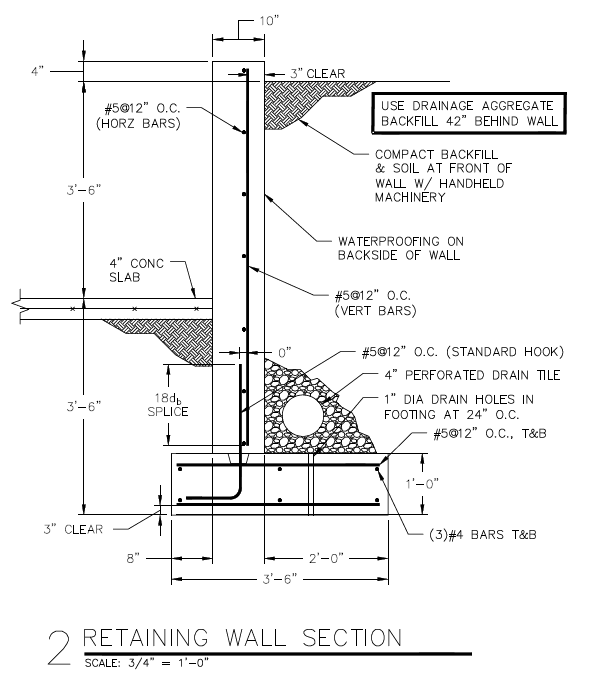mfstructural
Structural
- Feb 1, 2009
- 230
I've been engaged to design a retaining wall in the backyard of the residence. I completed the design, which includes minimum rebar per ACI. The footing dimensions (heel and toe) were requested by contractor due to a sewer pipe. The contractor is the one that retained me as the city is required a stamped drawing from an engineer. I've included the drawing below. I'm getting pushback on the amount of reinforcing in the wall and footing, as they are saying they never put that much at that spacing. After reviewing the IRC which states:
R404.4
Retaining walls that are not laterally supported at the top and that retain in excess of 48 inches of unbalanced fill, or retaining walls exceeding 24 inches in height that resist lateral loads in addition to soil shall be designed in accordance with accepted engineering practice to ensure stability of the wall against overturning, sliding, excessive foundation pressure and water uplift. Retaining walls shall be designed for a safety factor of 1.5 against lateral sliding and overturning. The section shall not apply to foundation walls supporting buildings.
So, that contradicts all the minimum steel requirements set forth in ACI. If you take a look at my drawing you can see #5@12 vert and #5@14 horz in the wall plus bottom and top steel in footing. Also when looking at IRC, foundation walls in general that are 10 inches in width require reinforcing of #4@56" for a wall height of 7'-4" which is the total wall height (see attached image).
Which is the correct steel to use in this situation? There is no mention of conforming to ACI minimum T&S and flexural steel.

R404.4
Retaining walls that are not laterally supported at the top and that retain in excess of 48 inches of unbalanced fill, or retaining walls exceeding 24 inches in height that resist lateral loads in addition to soil shall be designed in accordance with accepted engineering practice to ensure stability of the wall against overturning, sliding, excessive foundation pressure and water uplift. Retaining walls shall be designed for a safety factor of 1.5 against lateral sliding and overturning. The section shall not apply to foundation walls supporting buildings.
So, that contradicts all the minimum steel requirements set forth in ACI. If you take a look at my drawing you can see #5@12 vert and #5@14 horz in the wall plus bottom and top steel in footing. Also when looking at IRC, foundation walls in general that are 10 inches in width require reinforcing of #4@56" for a wall height of 7'-4" which is the total wall height (see attached image).
Which is the correct steel to use in this situation? There is no mention of conforming to ACI minimum T&S and flexural steel.

